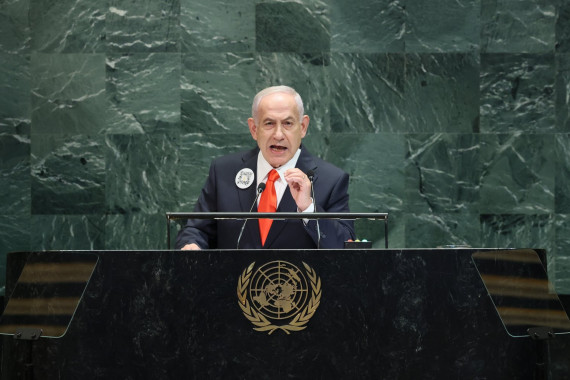
Israel’s biggest security threat has never been Hamas. It’s Netanyahu
Posted: 7th October 2025
Over the past two years, Israel has killed over 66,000 Palestinians in Gaza, the vast majority of whom were civilians, including 20,000 children. Tens of thousands more have been wounded, many with life-changing injuries, or are still missing, mostly buried under rubble.
This mass slaughter of Palestinians, which a UN commission of inquiry last month found to be a genocide, has been the utterly devastating Israeli response to the Hamas attack on 7 October 2023, when paramilitaries killed 1,195 people in southern Israel and took 251 people hostage.
What was scarcely mentioned in the initial reaction to Hamas’s assault is that it followed numerous Israeli Defence Force attacks on Gaza (which Hamas has had political control of since 2007) over the preceding 15 years, which killed around 5,000 Palestinians in total and injured thousands more.
Now, after two years of war, the 20-point peace plan unveiled by Donald Trump sparked some brief optimism last week after Hamas signalled partial acceptance by agreeing to a hostage exchange on Friday. That hope has already faded. A ceasefire seems unlikely, not least because Israel continued to launch air strikes and artillery shelling on Gaza City over the weekend, against the urging of Trump and members of his administration.
Will you help defend democracy?
- Keep openDemocracy free to read for everyone
- Provide our team with the support they need to work safely in a dangerous world
- Deliver the reporting that matters to you – and that reaches as many people as possible
An average of 100 people in Gaza are still being killed by the IDF every day, according to the United Nations Relief and Works Agency. The enclave’s Health Ministry also reported last week that 453 people, including 150 children, have died of starvation since the war started, as Israel’s closure of all border crossings has pushed Gaza into famine.
The extreme religious and nationalist elements that hold the balance of power in the Israeli government want full ethnic cleansing, followed by the enclave’s development and resettlement into a thriving Jewish domain – a process already in its early stages and causing huge suffering. They are unlikely to agree to any plan that falls short of this.
In any case, it is worth considering what peace would look like under the US-led plan. This would involve the release of all 48 remaining Israeli hostages, only 20 of whom are thought to still be alive, in exchange for the release of hundreds of Gazans detained in Israel, as well as the disarmament and surrender of Hamas and the complete IDF withdrawal from Gaza “within 72 hours” of the deal being agreed.
Substantial humanitarian aid would be sent to Gaza, and a temporary transitional entity centred on “a technocratic and apolitical Palestinian committee” would be established to handle Gaza’s governance. Crucially, this body would be overseen by an international “Board of Peace” chaired by Trump, with former UK prime minister Tony Blair the first person named as a member.
The involvement of Blair and his think tank, the Tony Blair Institute for Global Change (TBI), has raised many an eyebrow, not least because of Blair’s decision to invade Iraq in 2003 and the TBI’s record of funding and working with autocracies around the world.
Blair works closely with Larry Ellison, the co-founder of software company Oracle and the world’s second-richest person, who has donated or pledged over £250m to the TBI in the past four years, helping it grow a staff of more than 900 in around 45 countries.
With the TBI at the heart of the Board of Peace and Trump as its head, then in the unlikely event that a peace process did evolve, it would be dominated by Western thinking on security; the kind that gave us the disastrous wars in Afghanistan, Iraq, Libya and elsewhere.
Join our FREE online event on 15 October
“We are all arrestables now.”
Teenagers, grandparents, lawyers, doctors and vicars have all been arrested for demanding an end to the climate crisis, to genocide, to police brutality. And anti-protest laws introduced by the Tories have continued under Labour.
Join openDemocracy for our online event on 15 October where we will discuss the impact of the anti-protest laws on free speech in the UK – and learn how you can keep safe while standing up for your rights.
You will hear from activists, lawyers and have a chance to ask questions about the issues raised, and make connections with other activists who care deeply about creating a fairer and more just society.
And while Trump’s peace plan was cautiously welcomed by leaders of countries across the Islamic world, it leaves many questions unanswered, in particular over its relevance to a future independent Palestine.
Given Binyamin Netanyahu’s government’s fundamental opposition to a two-state solution, Trump’s plan is hardly helpful in saying: “While Gaza redevelopment advances and when the Palestinian Authority reform program is faithfully carried out, the conditions may finally be in place for a credible pathway to Palestinian self-determination and statehood, which we recognise as the aspiration of the Palestinian people.”
In any case, Netanyahu’s record of breaking ceasefires – not to mention Israel’s attack on Hamas negotiators in Qatar last month – means the chances of any lasting end to the conflict are low. Indeed, the Israeli PM has since announced that even if the hostages are released, the IDF will remain in “most” of Gaza, rather than withdrawing. Trump, meanwhile, stated that Hamas had three or four days to accept the deal in full or “pay in hell”.
So, two years on from its start, the war on Gaza seems set to continue – and will likely worsen as Netanyahu pushes ahead with his aim of the complete “destruction” of Hamas.
Israel wants to remain “impregnable in its insecurity”, as it has been virtually from the start of the Zionist project in the 1890s. In 1882, there were 24,000 Jewish people in what is now known as Israel and the occupied territories, and ten times as many non-Jews. By 1947, 30 years after the British promised Jews a homeland in the Balfour Declaration, the area’s Jewish population had risen to 630,000, although non-Jews still numbered more than twice that.
In the almost 80 years since, Palestinians have been under near-constant pressure and increasingly rigorous control, most notably with the Nakba in 1948, the Six-Day War of 1967, the response to the second Intifada in the early 2000s, as well as the many conflicts over Gaza and the current assault.
As to the future, there are serious problems ahead for both Israel and Palestine, even if the conflict in Gaza ends. The Netanyahu government’s decision to kill thousands of Palestinians and imprison and torture many more has trashed Israel’s international reputation; the country is now widely seen as a pariah state, and increasingly as a terrorist state.
One consequence of this is the rise in antisemitism across the world. Last week, two people were killed in a horrific terrorist attack at a synagogue in Manchester, in the north of England, on Yom Kippur, the holiest day in the Jewish year. There has also been a rise in antisemitic attacks in the US and Europe, and this trend is likely to continue as long as Palestinians are being persecuted.
Meanwhile, support for Palestinians will also remain high, including in countries that have been sympathetic to Israel in the past. This may even include the one country where Israel needs continuing support: the US. There, that support is ebbing away, with even some MAGA supporters now changing their minds.
Perhaps the most damning result of what is happening is the mass radicalisation of young Palestinians and of future Palestinian generations. As Israeli and US security experts have acknowledged, talk of Hamas being defeated is delusional – Hamas is as much an idea as a movement, and that idea will not only persist but will grow.
In short, the greatest threat to the security of Israel comes not from Hamas and its successors but from the Netanyahu government itself.
